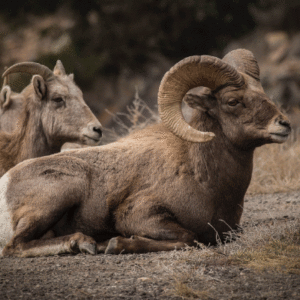 Imagine driving down I-70 near East Vail and catching a glimpse of a large tan mammal with a white rump standing on the side of the road. You think it’s just another mule deer but after a double take, you notice the massive horns on the animal’s head. You realize that you just passed by one of Colorado’s majestic mammals – the Rocky Mountain bighorn sheep!
Imagine driving down I-70 near East Vail and catching a glimpse of a large tan mammal with a white rump standing on the side of the road. You think it’s just another mule deer but after a double take, you notice the massive horns on the animal’s head. You realize that you just passed by one of Colorado’s majestic mammals – the Rocky Mountain bighorn sheep!
This is truly a unique sighting, because there are fewer than 45,000 bighorn sheep scattered throughout the extremely rugged terrain of the Rocky Mountains in United States and Canada; and Colorado is home to just over 7,000 sheep (more than any other state). With this healthy population of bighorns, coupled with the fact that Colorado has the more than 1,000 peaks over 10,000 feet high, it does not come as a surprise that on May 1, 1961, the Rocky Mountain bighorn sheep was adopted as the official state animal for Colorado.
As you continue down the highway you can’t help but wonder – why the bighorn sheep? Did the adoption of the Rocky Mountain bighorn sheep as Colorado’s state animal have to do with the idea that, just like many Colorado residents, bighorn sheep live life on the edge? Whether a visitor or a local, we all love to play in the rugged landscape of the Eagle River Valley, prime habitat shared with the bighorns. When you are racing down the mountain on a bike or skis, it’s all for fun and enjoyment; but for a bighorn, it could be a matter of life and death.
Bighorn sheep are famous for making death-defying jumps and embarking on death-defying climbs, things that we humans might try if we are daring and roped in, but for bighorn sheep, these are essential activities for evading predators and finding optimal feeding grounds. Their specifically adapted hooves allow the sharp, outer edge to cut into stone, while an inner elastic pad grips the rock better than any climbing shoe. If this is not extreme enough, next time you take 15 minutes to ride the gondola to the top of Vail Mountain, remember that a Rocky Mountain bighorn can summit the mountain in only 8 minutes – and they’re not hitching a ride.
But if the Bighorn’s extreme lifestyle, similar to that of many human Colorado natives, is not enough to convince you of their worthiness in being named our state mammal, consider the unique needs of this species. Perhaps, in 1961, state legislators adopted the species as a means to protect it. Rocky Mountain bighorn sheep habitat is limited to the mountainous areas of the Rockies. During that time, settlement was bringing fences, ranches, and towns that disrupted the sheep’s winter downslope migration patterns. Bighorn sheep habitat was also being reduced at unprecedented rates due to fire suppression which enabled forests to expand into the mountain grasslands, prime real estate for the bighorn sheep.
The extreme lifestyle and the need for protection are only two reasons that could explain the adoption of bighorn sheep as Colorado’s State Animal. Today, the Colorado bighorn population is healthy, and wildlife managers continue to emphasize efforts to maintain this population by enhancing bighorn habitat through methods such as controlled burns and wildlife bridges. The next time you are driving throughout the Eagle River Valley, keep your eyes open, as the Colorado Parks and Wildlife have identified a herd of approximately 40 sheep living on the southern cliffs near East Vail, as well as a smaller herd living near the lower elevations between Eagle and Gypsum.
To learn more about the Rocky Mountain bighorn sheep, visit staff from Walking Mountains Science Center at the Vail Nature Center opening June 2019.
Dustin Hall is the School Programs Coordinator at Walking Mountains Science Center. Similar to the Rocky Mountain bighorn sheep, he enjoys exploring the mountainous areas throughout the Eagle River Valley.








